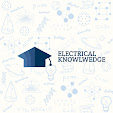N-TYPE SEMICONDUCTORS/ P-TYPE SEMICONDUCTORS
N-TYPE SEMICONDUCTORS/ P-TYPE SEMICONDUCTORS
N-Type Semiconductors
Thus far we have seen that pure semiconductor crystals
are very poor conductors. High temperatures can make them semi-conduct because
thermal carriers are produced. For most applications, there is a
better way to make them semiconduct. Doping is the process of adding another material called impurities to the silicon crystal to change its electrical
characteristics. One such impurity material is arsenic. Arsenic is known as a
donor impurity because each arsenic atom donates one free electron to the
crystal. Arsenic is different from silicon in several ways, but the important
difference is in the valence orbit. Arsenic has five valence electrons When an
arsenic atom enters a silicon crystal, a free electron will result. The
covalent bonds with neigh[1]boring
silicon atoms will capture four of the arsenic atom’s valence electrons, just
as if it were another silicon atom. This tightly locks the arsenic atom into
the crystal. The fifth valence electron cannot form a bond. It is a free
electron as far as the crystal is concerned. This makes the electron very easy
to move. It can serve as a current carrier. Silicon with some arsenic atoms
will semi-conduct even at room temperature. Doping lowers the resistance of the
silicon crystal. When donor impurities with five valence electrons are added,
free electrons are produced. Since electrons have a negative charge, we say
that an N-type semiconductor material results.
P-Type Semiconductors
Doping can involve the use of other kinds of
impurity materials Note that boron has only three valence electrons. If a boron
atom enters the silicon crystal, another type of current carrier will result. t
one of the covalent bonds with neighboring silicon atoms cannot be formed. This
produces a hole or missing electron. The hole is assigned a positive charge
since it is capable of attracting, or being filled by, an electron. Boron is
known as an acceptor impurity. Each boron atom in the crystal will create a
hole that is capable of accepting an electron. Holes serve as current carriers.
In a conductor
or an N-type semiconductor, the carriers are electrons. The free electrons are
set in motion by an applied voltage, and they drift toward the positive
terminal. But in a P-type semiconductor,
the holes move toward the negative terminal of the voltage source.
Hole current is equal to electron current but opposite in direction.


No comments:
If you have any doubts, please let me know